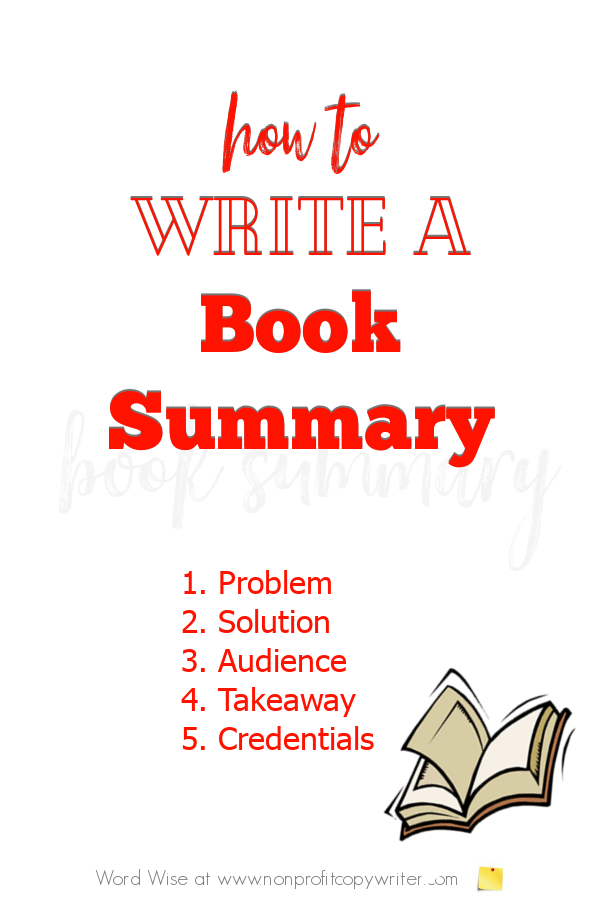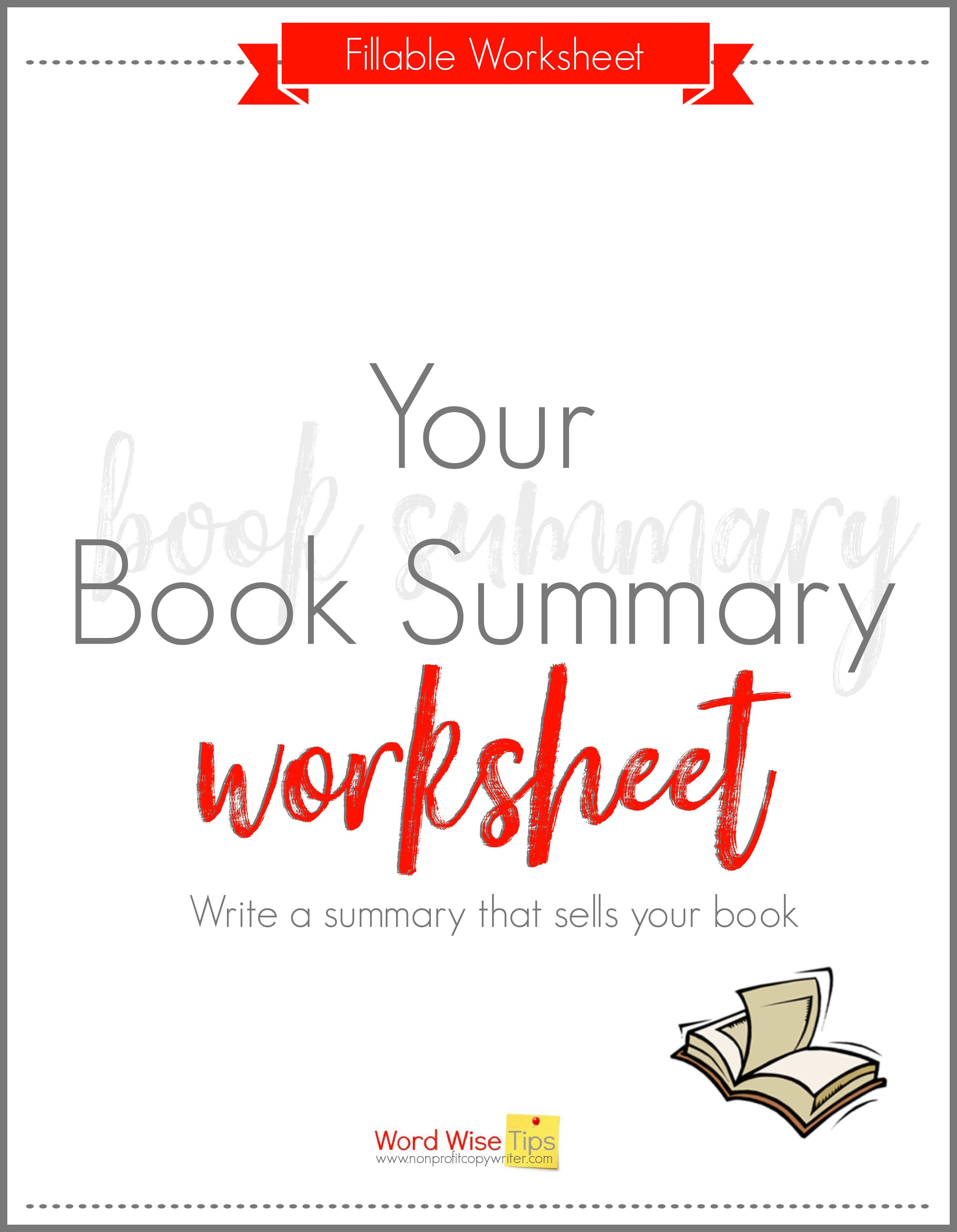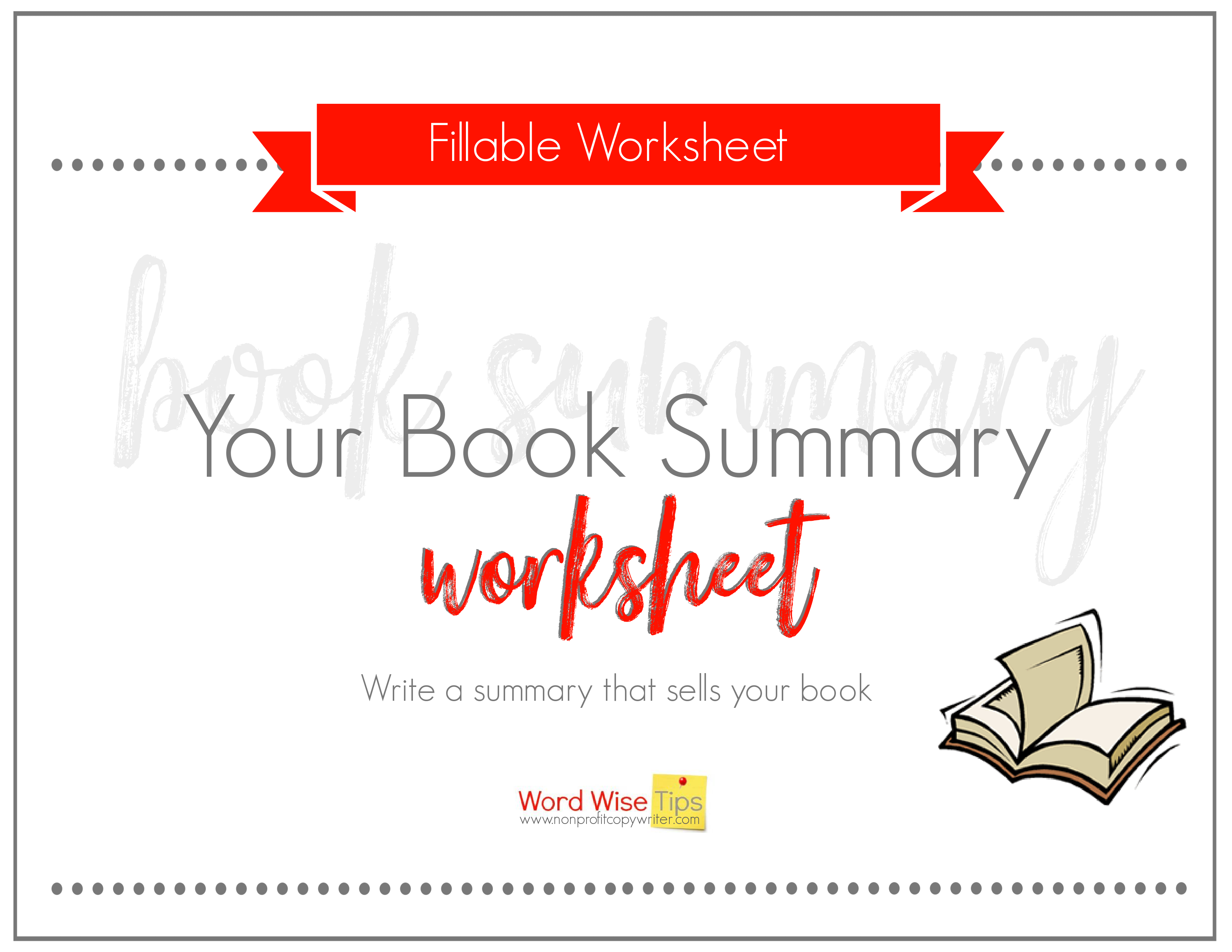Save Time: Get 5 Simple Writing Tips
you can put to use in 10 minutes
How to Write a Book Summary that Sells Your Book
Award-winning writer Kathy Widenhouse has helped hundreds of nonprofits and writers produce successful content , with 750K+ views for her writing tutorials. She is the author of 9 books. See more of Kathy’s content here.
Updated 12.29.2023
If you’re writing a book, then you need to know how to write a book summary. It’s a short piece of content that answers the all-important question, “What’s your book about?”
You’ve read zillions of book summaries. But you might not have even known the impact a good (or not so good) book summary has had on you.
It happens when you scan titles at the library or selections that come up on your Kindle feed. A title pops out to you. You review the blurb on the back cover of a book or on the Amazon page … and you choose the book for your Must-Read List.
Or not.
That blurb you reviewed that made you choose yea or nay? It’s a book summary. Which shows why you need to write a book summary that persuades. It’s a crucial piece in marketing your book
The difference between a book summary and a book synopsis
Before we dig into the practical how-tos you need to know to write a book summary, let’s make a fundamental distinction. There’s a difference between a book summary and a book synopsis. They seem like they could be the same thing. But they’re different in their purpose and their length.
A book summary targets readers. It’s the content on the back of the book and it has a singular goal: to get potential readers to read the book. That’s why a book summary is short – about 150-200 words. A non-fiction book summary describes a problem the reader faces and how the book solves it. A fiction book summary introduces the characters and the conflict between them – but does not reveal how the conflict is resolved. It leaves potential readers in suspense (so they buy the book or borrow it from the library).
A book synopsis, too, is a piece of persuasive writing – but it targets publishing houses and agents with the goal of a publishing contract or representation. A book synopsis is longer than a book summary, typically clocking in at 500-800 words. Agents and publishers often post guidelines that outline their book summary requirements.
A non-fiction book synopsis, like a book summary, describes a problem the reader faces and how the book solves it. But a synopsis also gives more detail about both the target audience and the solution, even brief one-sentence summaries of each chapter’s contents.
A fiction book synopsis introduces the main characters, a summary of the main plot, brief explanations of sub-plots and (get this) – the book’s conclusion. Potential publishers and agents need to know the ending so they decide if they’ll represent the author or publish the book.
Write a book summary to guide you as you write
While writing a book summary has clear advantages in the book marketing process, your book summary has immense benefits for you as you write. It gives you clarity at all stages of the writing process.
During the planning stage
Write a book summary to define your target audience's main problem, how your book will solve it, and what special niche your book will fill.
During the writing stage
Use your book summary as a guide in writing your book outline and staying on point as you complete the manuscript.
During the publishing and marketing stage
Use your book summary to promote your book.
Check out this “fill-in-the-blanks” re-usable Book Summary Worksheet that helps you gather the 5 elements and write a book summary that sells your book.
How to write a book summary: 5 steps
Here’s the approach I’ve used to write a book summary for my nonfiction books. (A fiction book summary will look different). I start by gathering these five elements.
1. Problem
What problem do readers face? Your book will solve it. But you need to clearly identify the issue.
Let’s look at an example by studying the seed idea for a book. You’ve struggled to give your children quality time with their grandparents. In the process you’ve found practical, creative ways to connect those two generations.
Example: Today’s children need more time and better-quality time with their grandparents.
2. Solution
How does your book solve the problem? Readers need to know that there’s a benefit from reading your book. Your book summary needs to address a pain point and provide answers.
Example: My book, Make the Most of the Time, offers creative ways for parents and grandparents to connect with grands, particularly for families who face challenging circumstances.
3. Audience
Who will read your book? When you know your target audience, then you can direct your content to them. Start by picturing your ideal reader – the kind of person you imagine devouring your book. Think of someone you know who fits your reader profile. Consider gender, age, worldview, experience, hobbies, interests, income, social position, purpose, and any other details that may be relevant. The more specific you can be, the better.
Example: Make the Most of the Time targets grandparents who want to spend more time with their grandchildren as well as parents who are willing to work with grandparents to make it happen.
4. Takeaway
How will your reader’s life be better or different after reading the book? In other words, spell out the benefit of your book or what the reader will take away with her. Maybe your book offers a special slant or approach or viewpoint. Or perhaps your book meets a need that’s not already addressed in the marketplace.
Example: Today’s busy families are separated by geography, schedules, and other conflicts. No matter what challenges you face as a grandparent – and no matter how many days, hours, or minutes you have with your grandchild – you can Make The Most of the Time to create and build purposeful connections.
5. Credentials
Why are you the person to write this book? You don’t need advanced degrees to speak authoritatively about a topic. List the relevant life experience, abilities, skills, or fitness that uniquely qualify you.
Example: For fifteen years, Annie Author and her family lived thousands of miles away from her children’s grandparents. Yet today, her children have close relationships with all four grandparents. Annie found ways to make it happen.
Use a simple book summary template
If you’ve done a good job gathering information about your book, then completing this simple book summary template will be easy. Just make sure you include the five elements.:
- Problem
- Solution
- Audience
- Takeaway
- Credentials
Check out this “fill-in-the-blanks” re-usable Book Summary Worksheet that helps you gather the 5 elements and write a book summary that sells your book.
A book summary example
Here’s a peek at a book summary example – one that uses the elements we gathered. It clocks in at less than 160 words, including the author credentials.
Grandparents add stability and consistency to a child’s life. But these days, grandparents and grandchildren have less time together than ever before because of distance, availability, work schedules, family conflict, and activities. [Problem]
Make Most of the Time offers practical, fun ways that grandparents can cultivate relationships with their grandchildren whether you’re … [Solution]
- a long-distance grandparent
- a working grandparent
- a caretaker grandparent
- an impaired grandparent
- a surrogate grandparent
- a parent facilitating the grandparent—grandchild relationship [Audience]
The next generation needs you. You can build healthy relationships with your grandchildren and use the life lessons you’ve gathered over the years to help them become strong and rooted individuals when you Make Most of the Time. [Takeaway]
Annie Author lived 2,000 miles from her parents and in-laws while raising her three children, but found creative ways to help foster vibrant, nurturing grandparent-grandchild relationships for her family. This book includes dozens of tips from Annie and parents like her. [Credentials]
A couple of extra points about writing a book summary
- You can include the five elements in any order.
- You can list your credentials in the author bio if you prefer.
- Include your book's main keywords in your book summary
- Where possible, write in second person. You want to directly appeal to potential readers.
Now that you have a book summary plan, get going a write one. And sell your book.
More Tips for Writing a Book
Use this Self-Publishing Checklist for a Winning Amazon Release ...
What Goes on the Back Cover of a Book?
6 Tips for Writing Good Copy for Your Book Jacket ...
The Back Matter of a Book: What to Write After You Write “The End..."
Use a Book Summary Worksheet to write a summary that sells ...
How to Identify the Problem Your Book Will Solve ...
How to Identify Your Book's Target Readers ...
How to Find Your Book's Unique Niche ...
How to Get Book Reviews for Free ...
Need to Write a Title for Your Book? Try This...
Write a Book Subtitle That Sells Your Book ...
How to Publish a Book for Free...
See more tips for Writing a Book on my Pinterest board...
Return from How to Write a Book Summary to Nonprofit Copywriter home
As an Amazon Associate I earn from qualifying purchases.
Share This Page

Named to 2022 Writer's Digest list
BEST GENRE/NICHE WRITING WEBSITE


Stop Wasting Time!
Grab your exclusive FREE guide, "5 Simple Writing Tips You Can Put to Use in 10 Minutes or Less"














